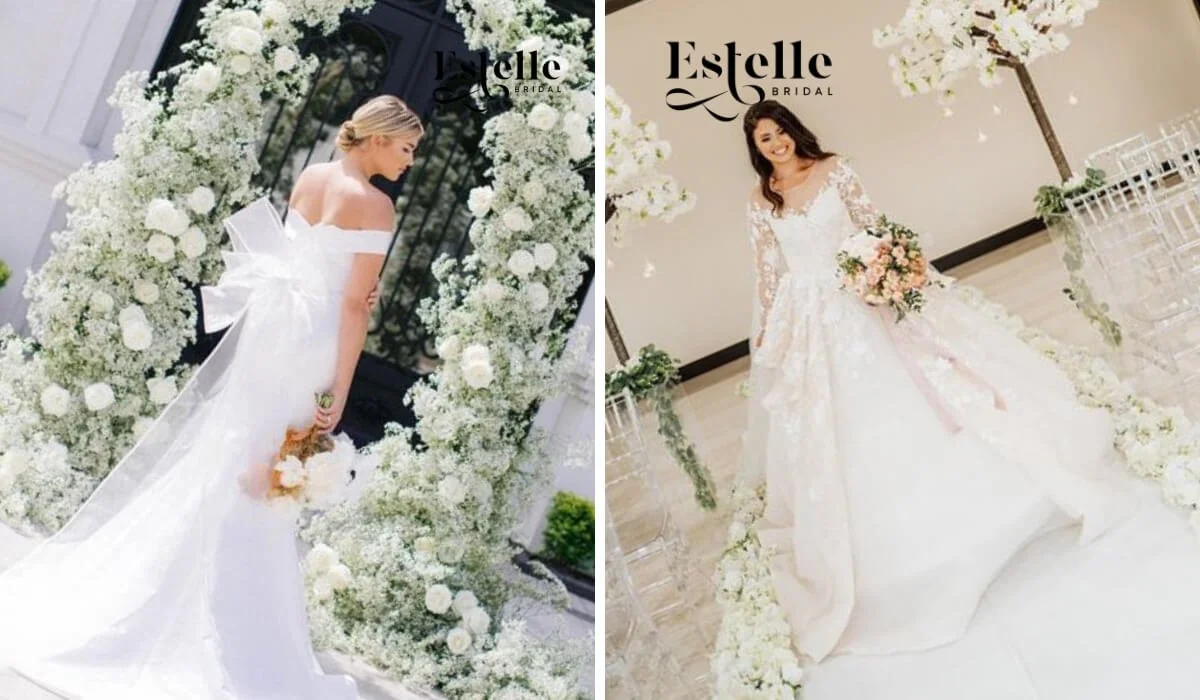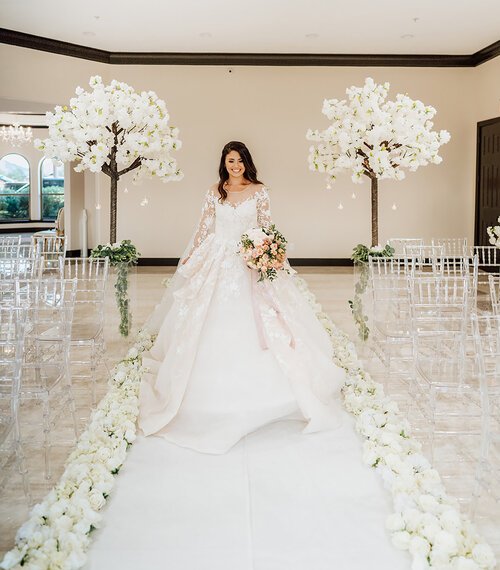What is the purpose of a custom wedding gown?
The purpose of a custom wedding gown is to create a unique, one-of-a-kind dress that is tailored specifically to the bride's style and preferences. A custom wedding gown allows the bride to work closely with a bridal designer to create a dress that is not only beautiful and comfortable but also reflects her personality and vision for her wedding day.
A custom wedding gown also allows for more flexibility in terms of design and customization, as the bride can choose the specific fabrics, embellishments, and details that she wants in her dress.
In addition, a custom wedding gown offers a more personalized experience than buying a dress off the rack. The bride can work directly with a bridal designer to ensure that every detail of the dress is perfect, and the designer can make adjustments and alterations as needed to ensure a perfect fit. This process can be especially meaningful for brides who want a dress that is truly unique and special for their big day.
What is the most important part of a custom wedding dress?
The most important part of a custom wedding dress is subjective and can vary depending on the bride's preferences and the style of the dress. However, some common features that many brides consider to be important include the fit and comfort of the dress, the style and design, the quality of the fabric and embellishments, and the overall aesthetic that the dress creates. Ultimately, the most important part of a wedding dress is that it makes the bride feel confident, beautiful, and special on her wedding day
Read More: Custom Bridesmaid Dresses That Make a Bold Statement
What material is a wedding dress made of?
Wedding dresses can be made from a variety of materials, depending on the style and design of the dress. Some typical materials used for wedding dresses include:
Silk: A luxurious and traditional choice for wedding dresses, silk can be lightweight and flowing or heavier and more structured.
Lace: A delicate and romantic material, lace can be used to create intricate patterns and embellishments on a wedding dress.
Tulle: A lightweight and sheer material, tulle is often used to create voluminous skirts or to add a touch of whimsy to a wedding dress.
Chiffon: A soft and lightweight fabric, chiffon is often used for flowing skirts or draping details on a wedding dress.
Satin: A smooth and glossy material, satin can be used for a variety of styles, from classic ballgowns to modern sheath dresses.
Other materials that may be used for wedding dresses include organza, crepe, and velvet, among others. The choice of material will depend on the desired look and feel of the dress, as well as the bride's personal style and preferences.
Why are wedding gowns white?
Wedding gowns are traditionally white because the color white has long been associated with purity, innocence, and virginity in Western culture. The white wedding dress is said to have been popularized by Queen Victoria of England, who wore a white gown for her wedding to Prince Albert in 1840. Before this, brides would typically wear their best dress or a dress in their favorite color for their wedding day.
Today, while many brides still choose to wear white, wedding dresses are available in a wide range of colors and styles to suit individual preferences and cultural traditions.
What are the main types of wedding dresses?
There are many different types of wedding dresses, each with its style and features. Here are some of the main types of wedding dresses:
Ballgown: A formal and traditional style of wedding dress, featuring a fitted bodice and a full, voluminous skirt.
A-line: A classic style of wedding dress with a fitted bodice and a skirt that flares out gradually, resembling the shape of an "A".
Mermaid: A fitted wedding dress that hugs the body and flares out at the bottom, creating a dramatic silhouette.
Sheath: A simple and elegant style of wedding dress that fits close to the body and drapes straight down from the hips.
Tea-length: A vintage style of wedding dress that falls to the mid-calf or just above the ankle.
High-low: A modern style of wedding dress with a hemline that is shorter in the front and longer in the back.
Two-piece: A non-traditional style of wedding dress that features a separate top and skirt or pants.
Jumpsuit: A contemporary and comfortable style of wedding outfit that features pants and a top in one piece.
There are many other types of wedding dresses, including bohemian, vintage, and modern styles, each with its unique features and aesthetic.
What is the difference between a custom wedding dress and a wedding gown?
There is no fundamental difference between a custom wedding dress and a wedding gown, as the terms can be used interchangeably to refer to a formal dress worn by a bride on her wedding day. However, the term "custom wedding dress" typically refers to a dress that is made to order and tailored specifically to the bride's measurements and preferences. A custom wedding dress is often designed from scratch by a professional bridal designer or created through a collaborative process between the bride and the designer.
On the other hand, a wedding gown can be a custom dress or a ready-to-wear dress that is purchased off the rack. A wedding gown can be made by a bridal designer or produced by a bridal brand or retailer. The term "wedding gown" generally refers to a dress that is formal and worn specifically for a wedding ceremony, regardless of whether it is custom-made or ready-to-wear.
Read More: 18 Whimsical Custom Wedding Gowns for a Magical Look
How many layers does a wedding gown have?
The number of layers in a wedding gown can vary depending on the style and design of the dress. Some wedding dresses may have only one or two layers of fabric, while others can have multiple layers. For example, a ball gown-style wedding dress may have several layers of tulle, organza, or other lightweight materials to create a voluminous skirt. A fitted mermaid-style wedding dress may have fewer layers of fabric but still, feature a built-in petticoat or crinoline for structure and shape.
In addition to the layers of fabric, a wedding gown may also have additional layers for lining, interfacing, or other structural elements to ensure a comfortable fit and proper drape. The exact number of layers in a wedding gown will depend on the specific design of the dress and the preferences of the bride.
How long do custom wedding dresses to come in?
The amount of time it takes for a custom wedding dress to be completed and delivered can vary depending on several factors, such as the complexity of the design, the availability of materials, and the schedule of the bridal designer. In general, a custom wedding dress can take anywhere from several weeks to several months to be completed.
It is recommended that brides begin the process of designing and ordering a custom wedding dress at least six to eight months before the wedding date to allow enough time for the dress to be completed and any necessary alterations to be made. However, some bridal designers may be able to work on a shorter timeline if necessary, especially if the design is less complex and materials are readily available.
It's important for brides to communicate their desired timeline with their bridal designer and to be flexible if any unexpected delays arise during the process.



